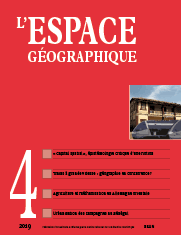

How to associate space and capital? Lessons learned on the notion of “spatial capital”
In the past few years, variations of “capital” have multiplied, some of which highlight one aspect or another of the spatial dimension: capital is said to be residential, spatial, (socio-)territorial, environmental, international, of mobility, of autochtony… It therefore seems essential to review these propositions, their effects and their relevance. This paper begins by focusing on the notion of spatial capital and its various uses. It shows that the meanings and the typologies associated with it are manifold; some are ephemeral, most are vague, sometimes without any explicit link between each other, or contradictory, and are difficult to articulate with the bourdieusian variations, the latter seen as theoretical references nevertheless. Finally, it is the very relevance of the expression itself that we challenge, as it implies a dualistic framework that considers the “spatial” a reality that is both separable and absent from the rest of the social world.
keywords: EPISTEMOLOGY OF GEOGRAPHY, PIERRE BOURDIEU, SEMANTIC ANALYSIS, SPACE CAPITAL, WORD OF GEOGRAPHY
The new Senegalese horizon. Population and urbanisation from Western lands to Eastern outskirts (2 encadrés; 10 fig.; 8 photos)
Several recent evolutions have modified the spatial distribution of the Senegalese population, which historically used to be in a few parts of the country: the densification of previously sparsely inhabited territories; the process of urbanisation, which expands to the whole country and is associated to the transformation of rural villages into fullfledged municipalities; the extension of the road network to areas that were previously isolated from urban centers. Despite the fact that the Eastern part of the country has long considered itself forgotten, and that the lower Casamance area remains home to irredentist mouvements partly due to its distance from the country centre, the national territory appears to be caught up by spatial dynamics that only concerned the West until then.
keywords: COMMUNALISATION, DENSITY, ROAD NETWORK, SENEGAL, URBANISATION
Introducing competition in Italian high-speed rail (10 fig.; 8 tabl.)
The purpose of this study is to analyse the impact created by the introduction of competition within the Italian high-speed rail (HSR) market. This paper aims at comparing the situation before and after the liberalisation process, taking into account the EU’s fundamental contribution from a legal point of view. To support this demonstration, economic and statistical analyses were used to estimate quantitatively changes and trends within the market. While some contradictory positions exist, for and against liberalisation, this paper also focuses on the issues related to the environment and to territorial development when considering the impact of competition. Finally this paper demonstrates how liberalisation has brought multiple benefits, also considering that the arrival of a new competitor on the market (Nuovo Trasporto Viaggiatori) has reduced travel prices and increased quality for customers, without decreasing the revenues of the incumbent company (Trenitalia).
keywords: COMPETITION, HIGH-SPEED RAILWAY, ITALY, RAILWAY MARKET, REGULATION
High-speed trains competition and territories (1 encadré)
The paper by Federico Antoniazzi and al. (2019) highlights the benefit of competition to increase the performance of rail operators engaged in the high-speed rail market. But what are the consequences of this competition on cities and the whole country? Our aim is to analyse the motivations and interests of four different stakeholders as regards to high-speed rail: passengers, railway companies, the railway infrastructure manager and public authorities, particularly the French State and local governments. Our main hypothesis is that competition boots networks’ dynamics which push for hubs, traffic and massification. Competition thus intensifies spatial disparities. Local governments, which are themselves in competition with each other to attract high-speed line investments, lessen the patchwork effect created by high-speed railway at the margins, with, as a result, the tremendous reduction of travel time between Paris and other major French cities. With the quick impacts of competition on one hand, and the longer temporality of social cohesion on the other, the forms of regulation between the different stakeholders have yet to be invented.
keywords: COMPETITION, HIGH-SPEED LINE, HIGH-SPEED RAIL, LOCAL GOVERNMENT, NETWORK, SPATIAL DISPARITY
Energy transition, transformation of agriculture and postsocialist legacies in East Germany (7 fig.; 2 tabl.)
This paper analyses the spatial dimension of a socio-technical change (biogas) in agriculture through the lense of the concepts and results of studies about the legacy of the inner German border. It shows to what extent these spatial legacies could shape the agricultural transformation induced by the socio-technical change and describes several transformation paths. Simultaneously biogas contributes to the transmission of these legacies, especially considering the role of the large scale farms created during the postsocialist transition.
keywords: AGRICULTURE, BIOGAS, BORDER, EAST GERMANY, PATH DEPENDANCY, RENEWABLE ENERGIES
L’espace géographique 3/19![]()
![]() L’espace géographique 1/20
L’espace géographique 1/20
For subscribe or buy this issue: BELIN
![]() L’Espace géographique: contents
L’Espace géographique: contents
Last modified: June 21, 2020